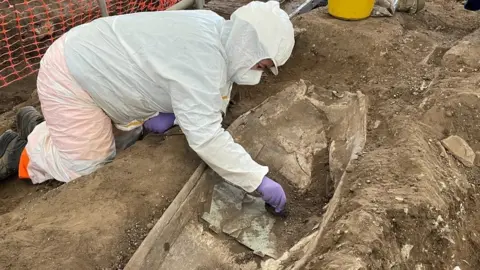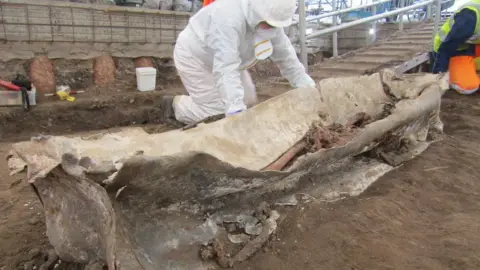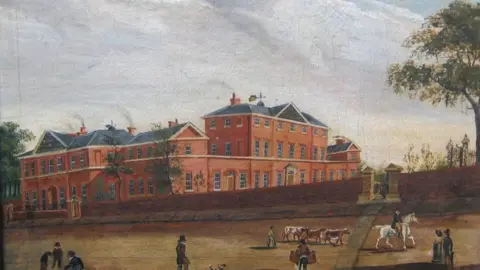Surgeon's remains found in lead coffin at Leicester Cathedral
 ULAS
ULASExcavations at Leicester Cathedral have uncovered the lead coffin of a surgeon at the city's Victorian asylum.
Edward Entwistle Wilkinson's remains were unearthed in a dig by University of Leicester archaeologists.
The find triggered research into his life and career as the first resident medical officer at the Leicestershire and Rutland County Lunatic Asylum.
Academics found he had made "a significant contribution" to modern medicine in the city.
The university team found Wilkinson's coffin while they were digging in the area of the cathedral's song school, which has been demolished to make way for a new visitor centre as part of the continuing Leicester Cathedral Revealed project.
It was among more than 1,000 burials so far revealed by the archaeologists in rows which were in use from the late 1820s to the closure of the cemetery in 1856.
 ULAS
ULASAmber Furmage, from University of Leicester Archaeological Services (ULAS), discovered Wilkinson, who lived from 1796 to 1846, was a house surgeon and apothecary at the Leicester Infirmary and the first resident medical officer of the then newly opened county asylum.
The asylum building would later become the first University of Leicester campus and is now called Fielding Johnson Building.
During his 17 years in the role, he expanded the dispensary, improved the medicinal planting in the hospital's garden and helped procure an Infirmary Carriage for Accidents.
At the asylum, his peers praised his talents and conduct and "his ability and tenderness in the treatment of patient".
Wilkinson died from typhus fever in July 1846 aged 50.
A plaque in the great south aisle of the cathedral was dedicated to him and his wife Elizabeth.
 University of Leicester
University of LeicesterMs Furmage said: "The discovery of a named individual is always exciting due to the amount of information we can track down about their lives, and this has been particularly true in the case of Edward Entwistle Wilkinson.
"Over his lifetime, he made significant contributions to the development of modern medicine in Leicester, leaving a lasting impact on the city and beyond."
The remains will be reinterred by Leicester Cathedral once the project is completed.

Follow BBC East Midlands on Facebook, on Twitter, or on Instagram. Send your story ideas to [email protected].
